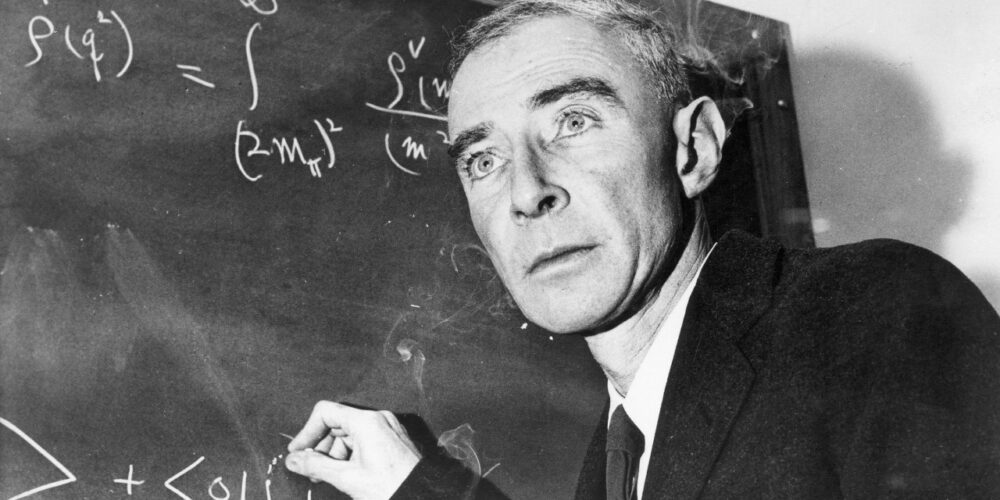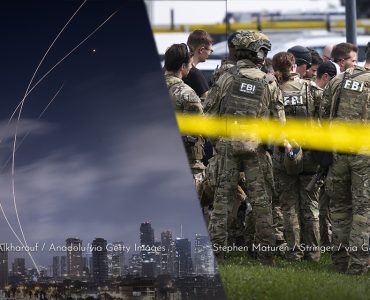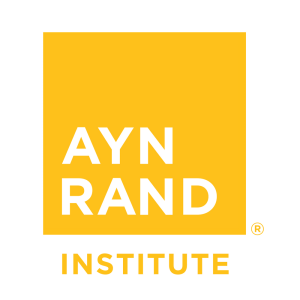Subscribe to the New Ideal podcast here.
With the release of Christopher Nolan’s film Oppenheimer, the epic story of creating the atomic bomb has received renewed attention. Almost seventy years ago, Ayn Rand headed up one of the earliest projects aimed at adapting that story to film. “Top Secret,” conceived and partially written by Ayn Rand in 1946, was intended to dramatize the idea that important inventions like the atomic bomb are possible only to free minds in a free society — a controversial theme that Rand explained and defended to her producer at the outset of the project. Rand’s research included two interviews with J. Robert Oppenheimer, the theoretical physicist who served as scientific director of the Los Alamos Laboratory. Archival documents — including Rand’s conceptual proposal, her research, her interviews, and her partial screenplay — provide a fascinating glimpse of the film that might have been.
Ayn Rand and “Top Secret”
In 1944, Ayn Rand signed a contract to write screenplays for Hal Wallis, the Hollywood producer who had brought Casablanca and The Maltese Falcon to the big screen.1 In late 1945, just after World War II ended with the decisive Hiroshima and Nagasaki bombings, Wallis gave Rand a new assignment: a screenplay centered on the Manhattan Project.
Rand’s first step was to outline her conceptual approach to making the film. In a twenty-six-page document called “An Analysis of the Proper Approach to a Picture on the Atomic Bomb,” Rand explained to Wallis why the movie’s theme should be: “Man’s greatest achievements are accomplished through free, voluntary action — and cannot be accomplished under force, compulsion and violence.”2 She emphasized that key scientists on the project became refugees because “Statism destroys, exiles and paralyzes men of genius,” because “these men could not work under compulsion,” and because “they could produce what they produced only in a free country.”3
Before undertaking the project, Rand needed Wallis’s understanding and support. “If there is any reason why this picture cannot be made honestly — it is better not to make it at all,” Rand wrote.4 “The responsibility is so great and so terrifying that unless we have the courage for it, we’d better leave the subject alone.” Without Wallis’s agreement, Rand was unwilling to continue. “If you agree with this exposition and wish to make the picture on this basis,” she wrote, “I shall consider it an honor and a privilege to work on the screenplay.”5
Wallis accepted, and Rand plunged into the research phase. To understand atomic science, she read Atomic Energy for Military Purposes, the lengthy and scientifically challenging official government report on the bomb’s development, written by the chairman of Princeton University’s physics department, Henry DeWolf Smyth.6 She also consulted with a technical advisor, a young physicist from the California Institute of Technology.7 To understand the human story, she sought interviews with key figures, including J. Robert Oppenheimer.
Interviewing Oppenheimer
Years later, in biographical interviews now preserved in the Ayn Rand Archives, Rand described her first meeting with Oppenheimer, noting that he seemed apprehensive and suspicious of the motivation behind Rand’s Hollywood project.8 He expressed worries about “the fate of science in the popular minds” and the “resentment of scientists for creating this weapon.”9 When Rand assured Oppenheimer that her screenplay was to “show that the atom bomb was a great achievement of the human mind, and that it can be done only by free minds,” the mood in the room suddenly changed.10 According to Rand, “What disarmed me was the way he looked at me after that. He literally said, ‘Oh, is this what you want to show?’ From then on . . . he began to talk much more warmly, personally, much more eagerly . . . he began to tell us anything we wanted, to tell stories.”11 They spoke for about an hour, and when the time was up, Oppenheimer requested that she “stay a little longer.”12 They talked all the way to the car as Rand departed, and seven days later, a second interview was scheduled.
With her theme for the movie clearly in mind, Rand asked Oppenheimer during that second interview whether the Los Alamos scientists worked under orders. “He looks at me,” Rand later recalled, “and in the way the best of my characters would have said it, he said, ‘There was never an order given at Los Alamos,’ and in that quiet, morally indignant tone.”13 In her interview notes, she wrote: “Reasons instead of authority.” By the end of the month, Rand had interviewed several other important players in the Manhattan Project, including Major General Leslie Groves, Colonel Kenneth Nichols, and Dr. Frederick Reines (who later won a Nobel prize in physics). She even spoke with Oppenheimer’s wife, Kitty.14
Drawing on her research and interviews, Rand began writing the screenplay and completed seventy-two pages (about one-third of the projected total length).15 This first part of the script includes scenes depicting the struggles of important nuclear scientists — including Enrico Fermi, Albert Einstein, Lise Meitner, and Niels Bohr — against growing statism in Europe. President Roosevelt makes an appearance when he is warned by the world’s foremost scientists that atomic weapons are possible and that the Nazis might be building a nuclear bomb. Rand also planned to include scenes that showed the contribution of American industrialists to the project, producing the uranium and plutonium that would make the bombs possible.16
In March 1946, much to Rand’s surprise and disappointment, Wallis sold all rights to the “Top Secret” project to MGM for $100,000.17 MGM then shelved it, and Rand’s screenplay was never completed or filmed. The project’s abrupt end came as a blow to Rand, but the timing was in one sense propitious. Her creative imagination was teeming with possibilities for the project that would become her magnum opus, Atlas Shrugged, and she spent the next few months planning and outlining that novel.
Interestingly, Rand’s experience with Oppenheimer helped inspire the character of Dr. Robert Stadler in Atlas Shrugged. In a series of notes written in the summer of 1946, she considered whether Oppenheimer could properly be described as the type of creator who works for his own destruction:
. . . he is so sure of what is right and that he is capable of deciding it, while others are not, that he must force it on those inferior others, for their own good. In such an attitude, there is the natural impatience of the intelligent man who can’t bear to see things done wrong, when they can be done right and he knows how to do it. But this attitude is applied to a crucial error in thinking — that one man can decide what is right (or good) for another. . . .18
Readers of Atlas Shrugged will recognize ways in which the Stadler character was inspired by Rand’s interactions with Oppenheimer.
Current controversies surrounding Nolan’s film, Oppenheimer, raise an interesting question: What kind of movie might Wallis and Rand have made together if “Top Secret” had come to fruition? Archival holdings permit well-founded speculation that the result could have been a masterpiece, if it had embodied Rand’s distinctive theme.19 As an expression of that theme, consider the line of dialog that Rand had planned for the final scene. After the bomb has fallen on Hiroshima, Dr. Oppenheimer’s young security guard looks to the sky and says: “Man can harness the universe — but nobody can harness man.”20
Image: ullstein bild Dtl. via Getty Images
Do you have a comment or question?
Endnotes
- Biographical interviews (Ayn Rand Archives).
- Ayn Rand, “An Analysis of the Proper Approach to a Picture on the Atomic Bomb” January 2, 1946, Ayn Rand Archives, 048_04B_009_012.
- Rand, “An Analysis,” 048_04B_009_013.
- Rand, “An Analysis,” 048_04B_009_002.
- Rand, “An Analysis,” 048_04B_009_026.
- Atomic Energy for Military Purposes (the Smyth Report), AtomicArchive.com.
- Biographical interviews (Ayn Rand Archives).
- Biographical interviews (Ayn Rand Archives).
- Biographical interviews (Ayn Rand Archives).
- Biographical interviews (Ayn Rand Archives); “Questions (Oppenheimer),” n.d., Ayn Rand Archives, 048_04B_002_002.
- Biographical interviews (Ayn Rand Archives).
- Biographical interviews (Ayn Rand Archives).
- Biographical interviews (Ayn Rand Archives); “Notes on interview with Dr. Oppenheimer,” dated January 15, 1946, Ayn Rand Archives, 048_04B_004_004; “Top Secret General Outline,” dated January 19, 1946, Ayn Rand Archives, 048_04B_007_013.
- Biographical interviews (Ayn Rand Archives); “Col. Nichols,” n.d., Ayn Rand Archives, 048_04A_002; “Notes of interview with J.R. Oppenheimer,” dated January 8, 1946, Ayn Rand Archives, 048_04B_003; “Notes on interview with Dr. Oppenheimer,” dated January 15, 1946, Ayn Rand Archives, 048_04B_004; “Notes on Interview with Gen. Groves,” dated January 16, 1946, Ayn Rand Archives, 048_04B_005; “Interview with Dr. Reines,” dated January 23, 1946, Ayn Rand Archives, 048_04B_006; “Interview with Mrs. Oppenheimer,” dated January 25, 1946, Ayn Rand Archives, 048_04B_010.
- Biographical interviews (Ayn Rand Archives); screenplay, “Top Secret” by Ayn Rand, dated February 15, 1946, Ayn Rand Archives, 048_04A_003.
- Screenplay, “Top Secret,” 048_04A_003; “Top Secret General Outline,” 048_04B_007_013.
- Biographical interviews (Ayn Rand Archives).
- “Notes, Types of creators who work for their own destruction,” dated June 22, 1946, Ayn Rand Archives, 159_13x_005_004.
- Readers who are curious to examine the published versions of Rand’s analysis, research and outlines may consult chapter 9 in Journals of Ayn Rand.
- “Top Secret General Outline,” 048_04B_007_017.







